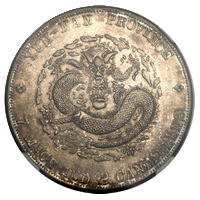Chinese Collectors Like Dirty Coins
There is a major difference between Chinese coin collectors and their contemporaries in the West that becomes apparent when one examines collectable coins from the two parts of the world. In the West, the penchant is for coins to be presented in a pristine condition: the shinier, the better. Such a condition is deemed to show that the coin has been well looked after – even loved – during its lifetime. This feeling is not prevalent amongst numismatists from China.
Chinese collectors prefer their coins to be worn, heavily toned, or even corroded. They believe that it is such discolouration, pitting, and marking, that shows the life within the coin. To the Chinese, a discoloured coin shows that it has been held, and used, and been a part of life. They like a coin to be ‘dirty’.
Serious collectors in the West will have their coins cleaned and conserved. They will have them independently graded, and then hold them in a safe, a vault, or even a safety deposit box. Somewhere they can be kept away from outside forces that may taint the coin in some way. Clean, unmarked coins receive better valuations and achieve higher on sell prices.
Not so with the Chinese, who often store their prized pieces in albums or folders. They enjoy looking at their collection and touching the coins. Its not uncommon for a Chinese collector to prove a coin’s authenticity by making it ring against another silver coin. A collector from the West might balk at even the suggestion of doing so.
The Chinese collector sees the ‘dirt’ on a coin as representing its past, as it was used for financial transactions. Holding and feeling the coin is simply a continuation of its life. It’s easy to understand that toning – the natural outcome of the ageing process – would be highly regarded in China. Silver oxidises naturally, and also reacts to different chemicals that it comes into contact with, and these processes create unique colour blemishes on each coin. It bears witness to the unique life of each coin. This is the reason that Chinese collectors do not treat such coins as ‘dirt’, but rather as something to be valued and respected.
Coin experts can tell from a coin’s toning where it comes from in China. Soils vary in the different provinces, and affect the chemical toning process accordingly. Those with a green colour to them usually come from the South, and blackened coins from the North. This adds to the historic picture of the coin, and adds to its value.
Because toning is seen as so important to a coin’s beauty and therefore desirability, it’s not surprising that unscrupulous dealers – and collectors – have many ways in which to forge it. Indeed, China is generally accepted as the biggest producer of fake coins in the world today.
Fortunately, even the novice eye can spot many of the methods of fake toning.
For example, ‘window sill toning’, where a coin is left in the sunlight to bake, makes the surface look dull. Exposing a coin to copious amounts of cigarette smoke, or china ink, will often leave an odour that will not disappear. Similarly, using chemicals to discolour the surface will leave a coin smelling foul.
Fake toning is designed to simulate flaws caused by light cleaning or hairlines, or to hide retooling or harsh cleaning, as well as artificial ageing. Forging coins is an industry in China, so most fake toning is conducted by chemical means.
Some black deposits are caused by covering the coin with a black substance, and then washing it to make it look like an old, but cleaned, coin. Others are soaked in chemicals that leave a green deposit on its surface, like the verdigris described previously. However, these will smell of the chemical, unlike genuinely buried silver coins.
For anyone collecting Chinese coins perhaps the best way of ensuring they are the genuine articles is to get them independently graded and verified as authentic.
One such coin is to come up for auction in the Heritage Auctions at the Long Beach Convention Centre in California on the 8th September. Expected to bring bids in excess of $1 million, the 1910 Chinese Dragon Dollar – called the Yunnan Spring Dollar – has been extensively researched, graded and certified AU58 by the Numismatic Guaranty Corporation (NGC). It is one of only two such coins known to be in existence.
The first was sold at auction in Beijing in 2002, and then resold in 2007 for $468,000. In 2010, it was sold on again for $1,035,000.
Both coins have been verified as coming from the same press, but the coin now up for auction is considered to be the better example. Bidding on the coin begins online in mid August.

1910 Chinese Dragon Dollar, picture courtesy of Heritage Auctions

